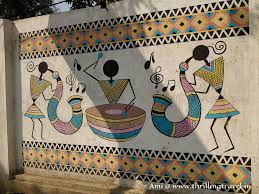
Tribal art forms like Gond and Warli, once rooted in rural rituals and storytelling, are now finding their place in urban landscapes. From the sides of cafes to large city walls, these traditional styles are being reimagined by contemporary artists and collectives.
In metros like Mumbai, Delhi, and Pune, street artists are using tribal motifs to speak about urban issues—pollution, migration, or digital life. While retaining the signature patterns and earthy colors, artists give new twists to ancient techniques. Trees take the shape of networks, and animals are depicted as symbols of survival in modern chaos.
This shift is more than aesthetic; it’s cultural dialogue. When tribal forms occupy city walls, they bridge rural wisdom and urban life. They also raise visibility for indigenous art, often overlooked in mainstream narratives. Collaborations between tribal artists and urban creators further enrich this evolution.
These murals are a form of cultural reclamation. They remind us that even in steel-and-glass jungles, there’s room for age-old stories. Gond and Warli, once tools of ritual, are now tools of reflection—and resistance—in city corners.
